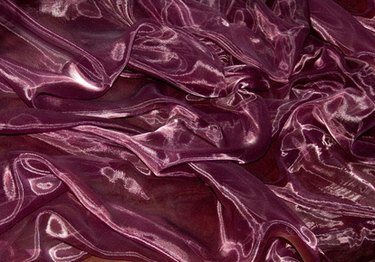
According to scientist Paula Burch, satin is a relatively fragile fabric because of the method of weaving the fibers together. Weaving procedures create large loops within the fabric that can easily be caught and torn, creating damage. Because of the delicate nature of this fabric, those who work it with it must take great care when performing any type of maintenance, including dyeing. Once you know what type of satin you have, you can carefully dye the fabric at home.
Things You'll Need
Scissors
Bowl
Tweezers
Lighter
Pot
Water
Disperse dye
Stove
Laundry soap
Soda ash
Fiber reactive dye
Spray bottles
Rubber gloves
Washing machine
Video of the Day
Burn Test
Step 1
Cut a small section of the satin fabric from a seam allowance or other area of the garment where it will not be noticed. This piece will be used to conduct a burn test, so that you can tell what type of satin you are dealing with.
Video of the Day
Step 2
Place an oven-safe bowl on a flat surface. Grasp the fabric with the tweezers and hold it over the bowl. Ignite a lighter and hold the fabric in the flame until it catches fire. Remove the flame.
Step 3
Observe the results of the flame test. If the fabric burns quickly, flares after the flame has been removed and produces harsh black smoke, it is either polyester or acetate satin. If the fabric burns slowly and produces little to no smoke, it is made of silk.
Step 4
Dispose of the burned fabric safely in a trash can after it has cooled completely.
Polyester and Acetate Satin
Step 1
Fill a pot large enough to hold your satin fabric with hot water. Mix in disperse dye; the amount of dye needed will depend on the size of your garment. Follow specific product instructions regarding the amount of dye and water needed.
Step 2
Dampen the satin in hot water and then place it in the dye bath. Place the pot on the stove and bring the water to a boil.
Step 3
Boil the garment in the dye bath for at least half an hour, until the garment has reached your desired shade of color. Remove the satin and rinse it thoroughly in hot water to remove residual dye.
Step 4
Hand-wash the garment with hot water and laundry soap to remove any remaining dye and seal the color.
Silk Satin
Step 1
Mix one cup of soda ash (also called sodium carbonate) into one gallon of room temperature water. Presoak the satin garment in this mixture; the soda ash will make the fabric more accepting of the dye. Allow the garment to soak for at least 15 minutes; it can safely soak for up to one hour.
Step 2
Mix a fiber reactive dye per product instructions. The amount of dye needed will vary depending on the size of the garment. Mix the dye into spray bottles.
Step 3
Wear rubber gloves to prevent dye from staining or harming your skin. Lay the garment flat on a workspace and spray the dye onto the garment. Massage the dye into the garment with your hands; continue to apply dye until you reach the desired shade.
Step 4
Allow up to 24 hours for the dye to settle onto the fabric; specific dye products may have specific drying times. Keep the garment moist during this time my spraying it with water; keep the garment in an area where the temperature is at least 70 degrees Fahrenheit to help the dye settle.
Step 5
Wash the dyed clothing in a washing cycle once with cold water to rinse the dye away. Wash twice in hot water to help the dye settle for good onto the fabric.
Tip
Polyester and acetate satin fabrics will only take color from disperse dyes. Find these and other dyes at fabric stores or craft retailers.
Warning
Do not sniff or touch any burned fabric until all smoke has cleared and the fabric is completely cool. Some fabric types can produce harmful fumes and can burn at very high temperatures, potentially causing severe burns.